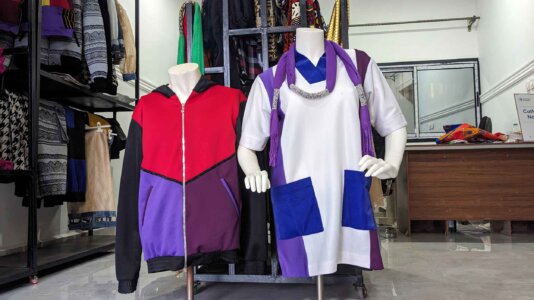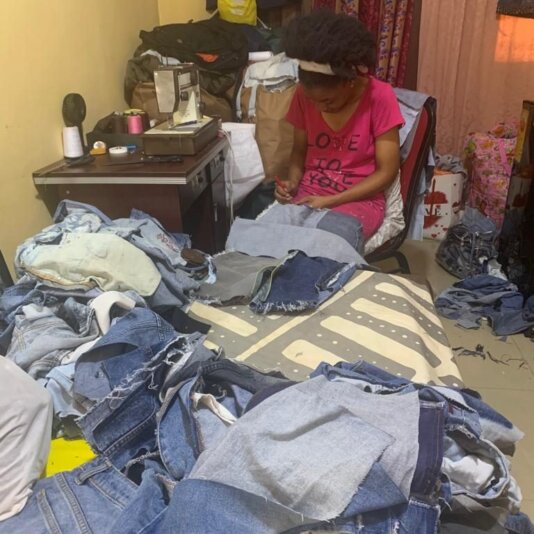- About
- Topics
- Picks
- Audio
- Story
- In-Depth
- Opinion
- News
- Donate
- Signup for our newsletterOur Editors' Best Picks.Send
Read, Debate: Engage.
| January 27, 2024 | |
|---|---|
| topic: | Sustainable Development |
| tags: | #Cameroon, #sustainable fashion, #climate action, #pollution |
| located: | Cameroon |
| by: | Andrew Nsoseka |
Nkwati Elsa-Rita is a Buea, Cameroon resident who cares deeply about what she wears. However, after realising the environmental impact of her clothing, she committed to significantly reducing her contribution to the problem, making eco-consciousness a core aspect of her lifestyle.
Elsa-Rita, inspired by Catherine Natang, has become a devoted advocate of the sustainable fashion movement and one of Natang's most loyal customers. She now takes pride in promoting the initiative and being part of the solution.
"Designs made using environmentally friendly fabrics match my fashion expectations, first because they are unique," Elsa-Rita told FairPlanet.
Catherine Natang, CEO of Catharina Natang, a Cameroonian fashion brand based in Buea, Cameroon’s Southwest Region, has harnessed her passion for fashion to fight plastic pollution.
The Ghana-trained fashion designer centres her work around three main pillars: using fabrics that are less harmful to the environment when discarded; reducing fashion waste by repurposing waste cuttings from her pieces; and redesigning old wears into new products to increase their lifespan.
In Cameroon, most people, especially youths, are deeply mindful of their fashion choices. They often want to stand out in unique designs and flashy outfits. But with rapidly-changing fashion trends, they frequently discard clothing items, which typically end up in garbage piles harmful to the environment due to a dysfunctional recycling system.
Some of this fashion waste is thrown into gutters in places with no waste collection points, often clogging up waterways. If they successfully go through, carried by runoff rainwater, they are swept into the sea, threatening aquatic life.
Announcing a deal to finance waste collection in Cameroon in 2017, the French Development Agency’s partly-owned PROPARCO said Cameroon produces 5.5 million tonnes of waste every year, or 16,000 tonnes per day.
Of this, the agency said, only 1.5 million tonnes of waste annually, or 4,000 tonnes daily, are managed in the 17 cities where HYSACAM, the company responsible for waste collection and management in Cameroon, operates.
Speaking to FairPlanet, Natang said that her mission is to ensure that people are able to dress well and that the environment and ecosystem at large do not suffer as a result.
Plastic pollution constitutes one of Cameroon’s greatest environmental challenges, with over 600,000 tonnes produced annually in the country. In cities like Yaounde, Douala and Buea, the effects are visible as, when it rains, discarded plastic products clog water channels and cause floods that lead to loss of lives and property.
Fashion products account for a great deal of the waste that ends up blocking waterways. 2021 data by OEC shows that Cameroon is the 18th-largest importer of used clothing. In 2021, the country spent over USD 93.3 million on used clothing, which only adds to the problem.
TRT World reports that the influx of used clothing into Africa largely serves as a method for disposing of millions of tonnes of fashion waste. This waste is often either directly discarded into the environment or burned, thus posing an additional environmental threat.
Natang shared that she wants to be part of the reason why in the years to come the fashion industry, which is currently regarded as third most polluting industry by some estimates, will become a sustainable sector.
Reflecting on her journey as a designer, Natang said sustainability has always played a role in her work. "When I started learning how to sew, before going to school, I was picking up pieces and redesigning them, just doing that for fun. I did not know that what I was doing was one aspect of sustainable fashion – redesigning from waste."
She added that her minor in Environmental Science from the University of Buea solidified her awareness of environmental health.
Natang was conscious of the fact that her sustainable fashion crusade would achieve little unless she brought other designers on board. So far, she has mobilised 85 fashion designers in Cameroon and around Africa to be part of her sustainable fashion network.
To keep them interested, Natang has offered a Training, Empowerment and Promotion (TEP) project to her peers. Most of the designers in Natang’s network are currently based in Cameroon, mainly in Buea, Douala, Yaounde and Bamenda, but some hail from Ghana, South Africa and Nigeria.
These 85 designers each produce an average of 600 Kilogrammes of waste a year. Natang said that over 66 per cent of the waste is used to redesign new fashion wears. These designs are mostly sold to locals in the community where the designers operate, and occasionally to individuals abroad.
In January 2023, Natang organised Cameroon’s first-ever sustainable fashion show, where participating brands and fashion houses took home cash prices to encourage them and others to embrace the trend.
Natang told FairPlanet that, so far, the journey has not been as smooth as she had hoped it would be. Her greatest challenge, she said, is convincing other designers to come on board and reconsider their approach to fashion design.
These designers were used to frequenting markets, purchasing any fabric, whether environmentally friendly or not, and designing wears that satisfied their clients. They were embedded in a system in which cuttings from their designs were either piled up in huge quantities for waste collectors to pick and dump at designated sites or, when waste collectors fail to show up, designers would burn such waste, polluting the air for local residents.
Natang’s initiative thus faces the challenge of inspiring a total behavioural shift by designers who come on-board while convincing customers that the flashy fabrics they crave are not always the best choice for the environment. Sometimes, she said, Natang ends up collecting designers' waste herself and redesigning new pieces from it.
"When using leftover cut pieces to design, no two things come out the same way," she said. However, she added, upon seeing the final products, some customers have grown to love the eco-friendly designs.
An additional challenge she faces is high operational and storage costs. Natang said that, unlike most fabrics, which contain a high degree of plastic in them, environmentally friendly fabrics are much more expensive to procure and require greater care. This, she noted, makes it difficult for many customers to buy them.
Aware that 60 per cent of dresses are made out of plastic, Natang, along with her 85 colleagues, is exploring opportunities to establish a fabric recycling and production plant. She believes this could help them create eco-friendly fabrics using raw materials such as banana stems and pineapple waste.
"When we get this recycling line, we will be able to tell people to bring us their old wears for recycling, instead of throwing them, so that they don’t pollute the environment with them," she said, adding that their aim is to produce high-quality wears appeal especially to the youth.
To streamline their efforts, Natang's team developed Fabric Recogniser, an app that scans fabrics to determine their plastic content. This helps designers in making informed decisions when selecting materials.
In April 2023, Natang and her team won an award for "Promoting Behaviour Change" among fashion designers in the fight against plastics. The award by Nesta UK and Challenge Works at the Afri-Plastics Summit and Awards was given in Nairobi, Kenya.
One only needs to open the app and take a good picture of the fabric for a detailed description of its plastic content to be generated, Natang said.
Ndimuh Shancho, a conservationist and Executive Director of Voice of Nature, describes Natang’s initiatives as "lofty and timely."
"It is coming at a time when the world is grappling with so many environmental challenges," Shancho told FairPlanet. "Everyone is trying at their level to save the world from further depleting, with more and more environmental challenges coming up daily."
The conservationist highlighted that, much like in other countries, the sustainable management of plastic waste remains a serious challenge in Cameroon.
"Statistics from Cameroon’s Ministry of Environment, Protection of Nature and Sustainable Development indicates that 600,000 tonnes of plastics are produced in Cameroon every year, and only about 20 per cent get recycled, so what happens to the rest? They end up in the streets, and we think that they have gone away.
"In July we saw what happened in Buea; in March we saw what happened in Limbe, where [...] improper handling of waste that block our waterways [contributed] to [deadly] floods."
He added that innovative solutions like that of Natang have to be encouraged and supported by the Ministry of Environment.
"We have to make sure that the four arrows of plastic solution are respected - that is in the areas of reuse, reduce, recycle and rebuy. We have to make sure that they become part of our daily reality in our strive to limit plastics pollution, which Natang has quickly figured out."
This approach, in his view, should not be limited to the fashion industry, but be adopted in other sectors as well.
Natang, on her part, believes that, "At its core, sustainable fashion is about creating clothing in a way that is environmentally responsible, socially just and economically viable."
64 per cent of nearly every piece of clothing contains plastics, she highlighted, either through dye or other fabrics. These microplastics, she pointed out, pollute the oceans, killing aquatic life and, in turn, causing illnesses to humans who consume seafood.
"Our oceans are polluted, with over 35 per cent of micro-plastics coming from the fabrics we wear, and it can take over 1,000 years to break down the micro-plastics settled at the ocean floor, affecting the algea - the ocean’s forest," Natang said. "Using materials and manufacturing processes that minimise the use of natural resources and reduce waste is a key aspect of sustainable fashion."
National Geographic reports that every year, about 8 million tonnes of plastic waste escapes into the oceans from coastal nations. Just One World further breaks down the figures, stating that between 20 to 35 per cent of plastic waste found in global freshwater bodies originates in the fashion industry.
It further confirms that when manufactured, washed, worn and eventually disposed of, synthetic clothes release plastic microfibers that pose risks to both animal and human health, as they mostly end up in fish and other sea life that is consumed by humans.
Sustainable fashion, Natang highlighted, can have an enormous positive economic impact on local communities by supporting small-scale production, promoting local sourcing and creating jobs that pay fair wages and provide safe working conditions.
Through eco-friendly fashion, she believes, we can help create a more sustainable and equitable world for future generations.
Image by Andrew Nsoseka.
By copying the embed code below, you agree to adhere to our republishing guidelines.



